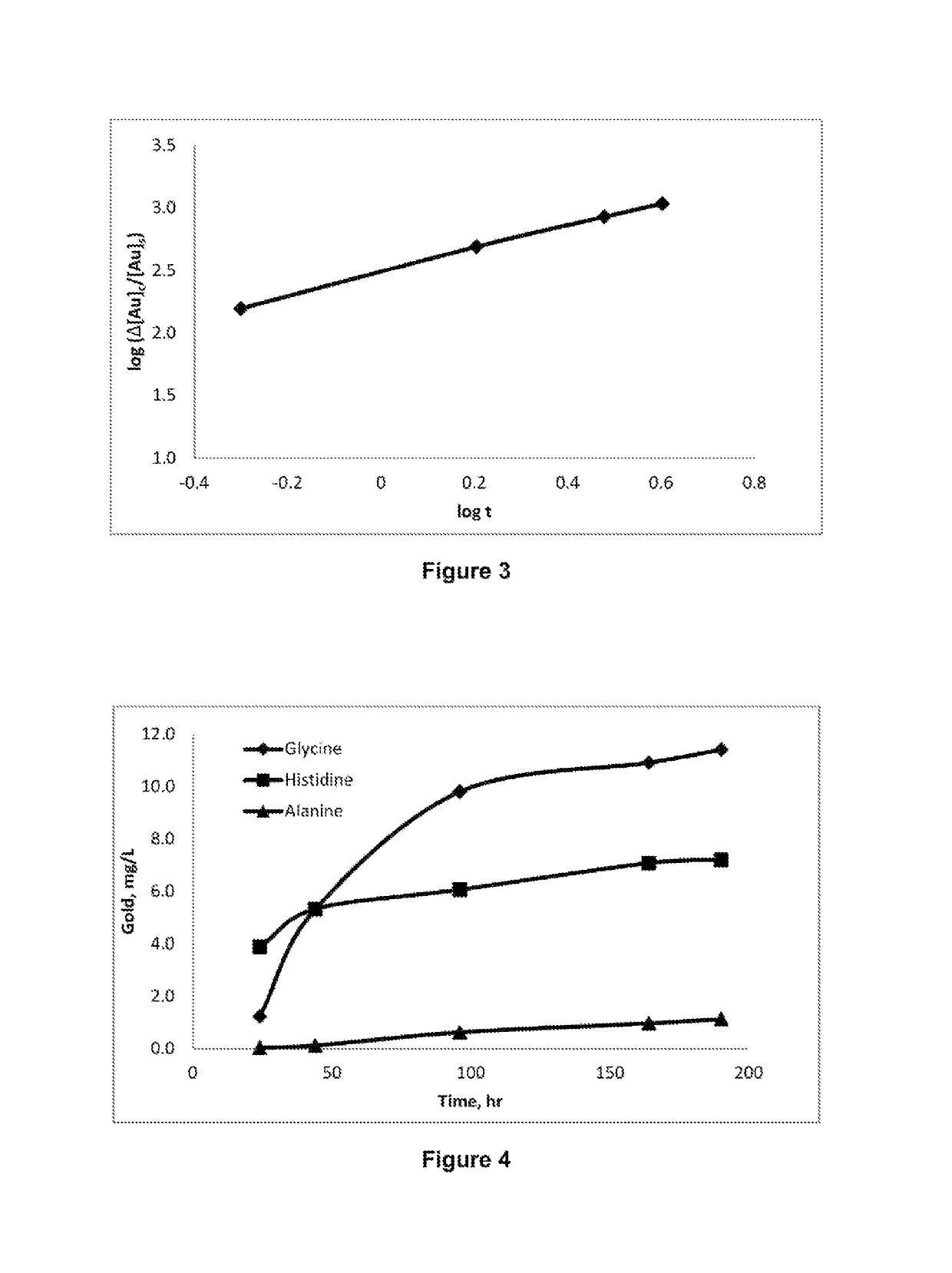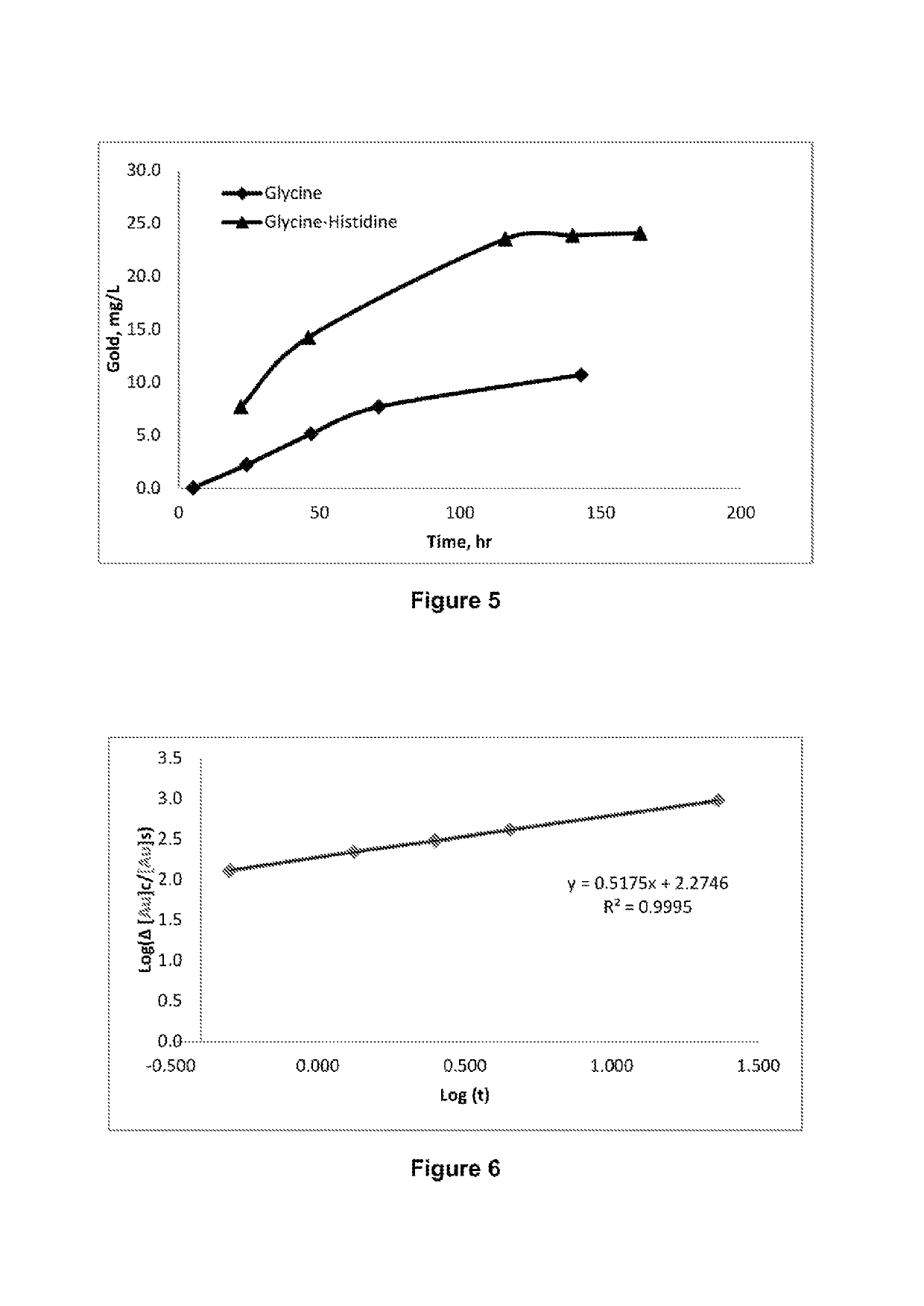Process for copper and/or precious metal recovery
- Summary
- Abstract
- Description
- Claims
- Application Information
AI Technical Summary
Problems solved by technology
Method used
Image
Examples
examples 1 to 15
Recovery of Precious Metal
[0132]All of Examples 1 to 15 were carried out using solutions prepared from either analytical grade or synthesized reagents and Millipore water. Unless specified, all Examples were conducted using magnetic stirrers and Teflon coated magnetic stirrer bars. The gold and / or silver was added to a solution of amino acid and peroxide in a beaker and heated to the required temperature while stirring. Gold and gold-silver sheets used in all the examples were made from 99.99% pure gold and silver. Before each experiment, the surface of the each sheet was polished with Struers waterproof silicon carbide paper (FEPA P#2400). Finally the gold sheet was washed with distilled water and allowed to dry.
[0133]For testing the carbon activity to adsorb gold-glycine complex, unless specified, 1.5 g / L of fresh carbon (−2.36+2 mm) was added into the pregnant solutions after leaching. The adsorption experiments have been conducted at room temperature at rotation speed of 150 rpm...
example 1
[0134]In Example 1, a solution containing 1M of the amino acid: glycine, and 1% of the oxidant, hydrogen peroxide, was used to dissolve pure metallic gold (as gold wire and gold foils) at a temperature of 60° C. FIG. 1 shows the amount of gold dissolved in solution (400 mL) containing 1M of glycine and 1% of peroxide over leaching time. It can be seen that gold dissolves under these conditions in reasonable amounts of up to 18 mg / L in 280 hours. In this example, lower reagents concentrations (0.1-0.4 M glycine), lower temperature (i.e. 40° C.) and natural pH of the solution (about pH 6) were also shown to be effective.
example 2
Effect of Glycine Concentration
[0135]The kinetics of gold dissolution in solutions containing different glycine concentrations and 1% hydrogen peroxide at pH 10 and temperature of 60° C. was studied and the results are plotted in FIG. 2. It can be seen from the results shown in FIG. 2 that, under the conditions of this Example, gold dissolution increases by increasing the glycine concentration up to 1 M. Table 1 shows the gold leach rate at different glycine concentrations.
[0136]
TABLE 1Gold leach rate at different glycine concentrations: Glycine, 1%H2O2, pH 10, 60° C.Glycine, MAu, 103 ×μmol / m2 · s0.3011.30.5016.91.0031.3
[0137]The gold leaching rate in glycine-peroxide system as shown in Table 1 can be significantly higher than the rates using thiosulfate-ferric oxalate and ferric EDTA systems in the absence of thiourea.
PUM
| Property | Measurement | Unit |
|---|---|---|
| temperature | aaaaa | aaaaa |
| pH | aaaaa | aaaaa |
| wt % | aaaaa | aaaaa |
Abstract
Description
Claims
Application Information
 Login to View More
Login to View More - R&D
- Intellectual Property
- Life Sciences
- Materials
- Tech Scout
- Unparalleled Data Quality
- Higher Quality Content
- 60% Fewer Hallucinations
Browse by: Latest US Patents, China's latest patents, Technical Efficacy Thesaurus, Application Domain, Technology Topic, Popular Technical Reports.
© 2025 PatSnap. All rights reserved.Legal|Privacy policy|Modern Slavery Act Transparency Statement|Sitemap|About US| Contact US: help@patsnap.com



